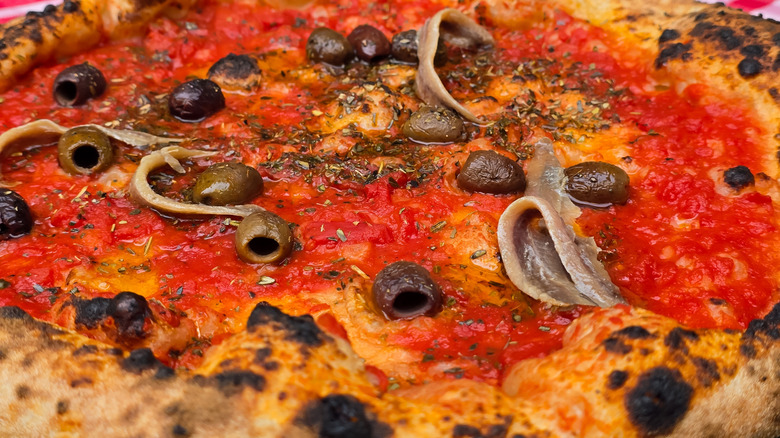The Sicilian Olive That Gives Pizza A Bright, Summery Twist
Most people gravitate toward the bold when it comes to olives, opting for Kalamatas's signature brine or the sharp tang of a tiny, plum-colored Niçoise. But there's another contender quietly winning over pizza lovers, snackers, and celebs alike: Castelvetrano. The olives, which boast Italian chef Giada Del Laurentiis in their fanbase, have an unassuming taste that's sweet and salty in equal measure.
This means its flavors don't dominate the dish, unlike its punchier counterparts, and it can sit well alongside a variety of toppings. The firm, snappy texture of the Castelvetrano can also add a satisfying contrast to other toppings, such as soft cheese or veggies, whether they're thrown on whole or roughly chopped. They're proof that, sometimes, the best ingredients are the ones that let everything else shine. Oh, if you're thinking olives should be the occasional indulgence, here's some good news: Castelvetranos are surprisingly light. They're also a natural source of omega-3 fatty acids, meaning they're not just a tasty choice, but a nutritious one.
What goes well with Castelvetrano olives?
Castelvetrano olives play well with a whole spectrum of pizza toppings, including mozzarella, nduja crumb, and tangy tomato bases. They're unlikely to overwhelm the other ingredients because of the way they're processed: A quick lye bath strips away the bitterness you get in many other olives. Their hearty, meaty texture makes them a perfect foil to fatty, cured meats such as salami. Together, they deliver a deeply satisfying bite that's salty, savory, and indulgent in equal measure. Castelvetranos can also stand up to bold Italian cheeses, such as Asiago or pecorino, and they really shine when paired with crisp, dry whites, such as sauvignon blanc or pinot grigio.
When it comes to pizza creation, combining salty, tangy, spicy, and umami flavors is not one of the mistakes you're making with pizza toppings. You might try balancing out the salty olives with sliced mushrooms, and some pepperoni for a fiery kick. Pizza al taglio, with its firm, focaccia-like base, is ideal for loading with toppings; it would be rude not to do as the Romans do, so chuck on some Castelvetranos alongside soft cheeses, leafy greens, and even eggs.
More tips for eating Castelvetrano olives
Of course, you don't need to cook Castelvetrano olives to enjoy them. They're a standout on any charcuterie board, offering a buttery contrast to sharp cheeses and sweet preserves. Want to turn them into a moreish snack? Toss them in flour and crisp them up in the air fryer for a crunchy, crowd-pleasing appetizer (just make sure they're pitted first).
Word of warning, don't pick these straight off the tree. You can't actually eat fresh olives, and Castelvetranos are no different; they must be cured before they're edible. If you see a version that looks a little too green (we're talking neon), be cautious — it could be artificially dyed, which is misleading and potentially illegal. Can't find Castelvetranos? No worries: Large green olives, such as California Sevillanos or Italian Cerignolas, work as substitutes. If you do come across the real deal, grab a jar. Castelvetrano olives deserve a star spot at your next pizza party.


